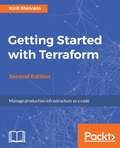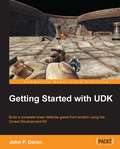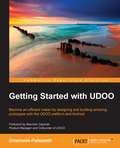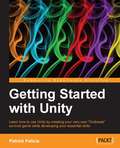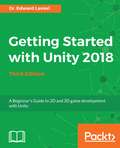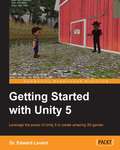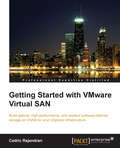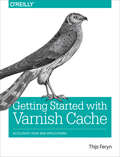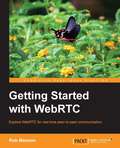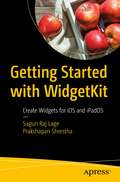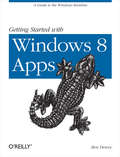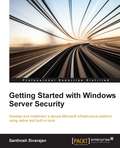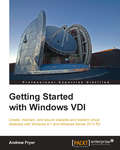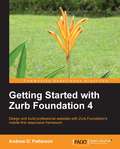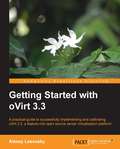- Table View
- List View
Getting Started with Terraform - Second Edition
by Kirill ShirinkinBuild, Manage and Improve your infrastructure effortlessly. About This Book • An up-to-date and comprehensive resource on Terraform that lets you quickly and efficiently launch your infrastructure • Learn how to implement your infrastructure as code and make secure, effective changes to your infrastructure • Learn to build multi-cloud fault-tolerant systems and simplify the management and orchestration of even the largest scale and most complex cloud infrastructures Who This Book Is For This book is for developers and operators who already have some exposure to working with infrastructure but want to improve their workflow and introduce infrastructure as a code practice. Knowledge of essential Amazon Web Services components (EC2, VPC, IAM) would help contextualize the examples provided. Basic understanding of Jenkins and Shell scripts will be helpful for the chapters on the production usage of Terraform. What You Will Learn • Understand what Infrastructure as Code (IaC) means and why it matters • Install, configure, and deploy Terraform • Take full control of your infrastructure in the form of code • Manage complete infrastructure, starting with a single server and scaling beyond any limits • Discover a great set of production-ready practices to manage infrastructure • Set up CI/CD pipelines to test and deliver Terraform stacks • Construct templates to simplify more complex provisioning tasks In Detail Terraform is a tool used to efficiently build, configure, and improve the production infrastructure. It can manage the existing infrastructure as well as create custom in-house solutions. This book shows you when and how to implement infrastructure as a code practices with Terraform. It covers everything necessary to set up the complete management of infrastructure with Terraform, starting with the basics of using providers and resources. It is a comprehensive guide that begins with very small infrastructure templates and takes you all the way to managing complex systems, all using concrete examples that evolve over the course of the book. The book ends with the complete workflow of managing a production infrastructure as code—this is achieved with the help of version control and continuous integration. The readers will also learn how to combine multiple providers in a single template and manage different code bases with many complex modules. It focuses on how to set up continuous integration for the infrastructure code. The readers will be able to use Terraform to build, change, and combine infrastructure safely and efficiently. Style and approach This book will help and guide you to implement Terraform in your infrastructure. The readers will start by working on very small infrastructure templates and then slowly move on to manage complex systems, all by using concrete examples that will evolve during the course of the book.
Getting Started with Twitter Flight
by Tom HamshereGetting Started with Twitter Flight is written with the intention to educate the readers, helping them learn how to build modular powerful applications with Flight, Twitter's cutting-edge JavaScript framework.This book is for anyone with a foundation in JavaScript who wants to build web applications. Flight is quick and easy to learn, built on technologies you already understand such as the DOM, events, and jQuery.
Getting Started with UDK
by John P. DoranThis book is written by someone who is passionate about games for those who are equally passionate about games. The step-by-step instructions contained within this guide will make creating your first game simple.If you have ever had the urge to know more about how all those amazing games you played for countless hours are created, then this book is definitely for you! This step-by-step tutorial will teach you how to create a complete game within UDK.Even if you have no prior experience of UDK, you can still start building the games you want today.
Getting Started with UDOO
by Emanuele PalazzettiIf you are an Android developer who wants to learn how to use UDOO to build Android applications that are capable of interacting with their surrounding environment, then this book is ideal for you. Learning UDOO is the next great step to start building your first real-world prototypes powered by the Android operating system.
Getting Started with Unity
by Patrick FeliciaGetting Started with Unity is written in an easy-to-follow tutorial format."Getting Started with Unity" is for[ 3D game developers[/color] who would like to learn how to use Unity3D and become familiar with its core features. This book is also suitable for intermediate users who would like to improve their skills. No prior knowledge of Unity3D is required.
Getting Started with Unity 2018: A Beginner's Guide To 2d And 3d Game Development With Unity, 3rd Edition
by Edward LavieriThe Unity game engine has revolutionized the gaming industry with its complete set of intuitive tools.. This book will guide you through the entire process of creating a 3D VR game, from downloading the Unity game engine to publishing your game. It not only gives you a strong foundation, but puts you on the path to game development.
Getting Started with Unity 2018: A Beginner's Guide to 2D and 3D game development with Unity, 3rd Edition
by Dr Edward LavieriLearn how to use Unity 2018 by creating your very own 3D game while developing your essential skillsKey FeaturesLearn to create immersive 3D games and Virtual Reality experiences with Unity 2018 Build custom scripts to make your game characters interactiveExplore and implement AritificiaI Intelligence techniques to bring your game to lifeBook Description The Unity game engine has revolutionized the gaming industry with its complete set of intuitive tools and rapid workflows, which can be used to create interactive 3D content. With Unity, you can scaffold your way from the basics and make make stunning interactive games. This book will guide you through the entire process of creating a 3D game, from downloading the Unity game engine to publishing your game. It not only gives you a strong foundation, but puts you on the path to game development. Beginning with an overview of the Unity engine and its interface, you will walk through the process of creating a game environment and learn how to use built-in assets, as well as assets created with third-party 3D modeling tools such as Blender. Moving on, you will create custom scripts to control non-player character behaviors and gameplay. You will master exciting concepts such as Heads-Up-Displays, mini-maps, game navigation, sound effects, and lighting effects. Next, you’ll learn how to create your first VR experience, right from setting up the project to image effects. You'll be familiarized with all the tools that Unity has to offer to create your own immersive VR experiences. Each section is a stepping stone toward the completion of the final game. By the end of the book, you'll have learned advanced topics such as cross-platform considerations which enable your games to run on multiple platforms.What you will learnSet up your Unity development environment and navigate its toolsImport and use custom assets and asset packages to add characters to your gameBuild a 3D game world with a custom terrain, water, sky, mountains, and treesAnimate game characters, using animation controllers, and scriptingApply audio and particle effects to the gameCreate intuitive game menus and interface elementsCustomize your game with sound effects, shadows, lighting effects, and rendering optionsDebug code and provide smooth error handlingWho this book is forIf you are an aspiring game developer interested in learning Unity 2018 and becoming familiar with its core features, then this book is for you. No prior knowledge of Unity is required.
Getting Started with Unity 5
by Dr Edward LavieriIf you are a game developer interested in learning Unity 3D from scratch and becoming familiar with its core features, then this book is for you. No prior knowledge of Unity 3D is required.
Getting Started with Unity 5
by Edward Lavieri<P><P>Leverage the power of Unity 5 to create amazing 3D games <P><P>About This Book <P><P>Learn to create interactive games with the Unity 5 game engine <P><P>Explore advanced features of Unity 5 to help make your games more appealing and successful <P><P>A step-by-step guide giving you the perfect start to developing games with Unity 5 <P><P>Who This Book Is For <P><P>If you are a game developer interested in learning Unity 3D from scratch and becoming familiar with its core features, then this book is for you. No prior knowledge of Unity 3D is required. <P><P>What You Will Learn <P><P>Create, organize, and manage your game project with the Unity interface <P><P>Develop a 3D game environment with a custom terrain, water, sky, mountains, and trees <P><P>Import and use custom assets and asset packages to add characters to your game <P><P>Review existing animations and create custom animation clips to bring your game characters to life <P><P>Build custom scripts to make your game characters interactive <P><P>Add a graphical user interface to your game to enable easy user interaction <P><P>Explore advanced Unity concepts including workflow, scaling, physics, and cross-platform considerations <P><P>Customize your game with sound effects, shadows, lighting effects, and rendering options <P><P>In Detail <P><P>This book will guide you through the entire process of creating a 3D game, from downloading the Unity game engine to publishing your game. <P><P>Beginning with an overview of the Unity engine and its interface, you will walk through the process of creating a game environment and learn how to use built-in assets as well as assets created with third-party 3D modeling tools such as Blender. <P><P>Moving on, you will create your very own animation clips from within Unity and learn scripting in Unity. You will master exciting concepts including mini-mapping, the game navigation system, sound effects, shadows, and light effects. By the end of the book, you'll have learned advanced topics such as cross-platform considerations that enable your games to run on every platform.
Getting Started with V Programming: An end-to-end guide to adopting the V language from basic variables and modules to advanced concurrency
by Navule Pavan RaoLearn a new statically compiled programming language to build maintainable and fast software with the help of this comprehensive guide to V programmingKey FeaturesExplore the features of the V programming language step by step with this beginner's guideGain strong foundational knowledge of core programming concepts such as modules, functions, and structsLearn how to write super-fast programs and applications that compile in a matter of secondsBook DescriptionA new language on the block, V comes with a promising set of features such as fast compilation and interoperability with other programming languages. This is the first book on the V programming language, packed with concise information and a walkthrough of all the features you need to know to get started with the language. The book begins by covering the fundamentals to help you learn about the basic features of V and the suite of built-in libraries available within the V ecosystem. You'll become familiar with primitive data types, declaring variables, arrays, and maps. In addition to basic programming, you'll develop a solid understanding of the building blocks of programming, including functions, structs, and modules in the V programming language. As you advance through the chapters, you'll learn how to implement concurrency in V Programming, and finally learn how to write test cases for functions. This book takes you through an end-to-end project that will guide you to build fast and maintainable RESTful microservices by leveraging the power of V and its built-in libraries. By the end of this V programming book, you'll be well-versed with the V programming language and be able to start writing your own programs and applications.What you will learnBecome familiar with the basic building blocks of programming in the V languageInstall the V language on various operating systemsUnderstand how to work with arrays and maps in V programmingDiscover how to implement concurrency in V programmingUse channels in V programming to learn the best practices of sharing memory by communicating among coroutinesWrite modular code and build on your knowledge of structs and functions in VGet acquainted with writing tests in V programmingGet to grips with building and querying RESTful microservice in VWho this book is forWhether you're a beginner interested in learning a programming language or an experienced programmer looking to switch to a new and better statically compiled programming language, this V programming book is for you.
Getting Started with VMware Virtual SAN
by Cedric RajendranThis book is intended for server administrators and storage administrators who would like to successfully build and scale a VSAN-backed vSphere infrastructure. A basic understanding of vSphere concepts and storage fundamentals will be helpful.
Getting Started with Varnish Cache: Accelerate Your Web Applications
by Thijs FerynHow long does it take for your website to load? Web performance is just as critical for small and medium-sized websites as it is for massive websites that receive tons of hits. Before you pour money and time into rewriting your code or replacing your infrastructure, first consider a reverse-caching proxy server like Varnish. With this practical book, you’ll learn how Varnish can give your website or API an immediate performance boost.Varnish mimicks the behavior of your webserver, caches its output in memory, and serves the result directly to clients without having to access your webserver. If you’re a web developer familiar with HTTP, this book helps you master Varnish basics, so you can get up and running in no time. You’ll learn how to use the Varnish Configuration Language and HTTP best practices to achieve faster performance and a higher hit rate.Understand how Varnish helps you gain optimum web performanceUse HTTP to improve the cache-ability of your websites, web applications, and APIsProperly invalidate your cache when the origin data changesOptimize access to your backend serversAvoid common mistakes when using Varnish in the wildUse logging and debugging tools to examine the behavior of Varnish
Getting Started with Visual Studio 2022: Learning and Implementing New Features
by Dirk StraussLearn how to use the features of Visual Studio 2022 and utilize the IDE correctly to make it your one-stop solution for creating quality code. Learn what's new in VS 2022 and explore the existing features of Visual Studio so you can become a more efficient programmer. This revised edition covers the latest features of Visual Studio 2022 and how to use them. The book includes new topics like Subword Navigation, Multi-caret Editing, how to enable Code Cleanup on Save, using breakpoints, and new debugging features such as temporary breakpoints and dependent breakpoints. The book also looks at some of the new Git features such as Multi-repo Support, Comparing Branches, Checkout Commit, and line Staging. Getting Started with Visual Studio 2022 begins with an overview of Visual Studio and explores features such as Visual Studio Live Share, Visual Studio Search, Solution Filters, and Intellicode. The author also provides a look at the different Visual Studio project templates and shows you how to create code snippets, as well as how to manage NuGet and nmp packages. You will also see how to create a cross-platform MAUI application as well as how to use SQLite in an MAUI application. Moving ahead, you will learn how to debug your code using breakpoints to step into specific methods, use data tips, and utilize the Debugger Display attribute. You will then move on to learn unit testing and explore the tools provided by Visual Studio to create and run unit tests. The book also covers source control integration in Visual Studio and how to use GitHub to implement a source control strategy for your projects. What You Will LearnCreate and use code snippets in Visual Studio 2022Use the new debugging features in Visual StudioUtilize diagnostic tools and the Immediate window for code debuggingGenerate unit tests with IntelliTestHarness the new Git features in Visual Studio to make managing source code easierWork with MAUI apps Who This Book Is For Beginners and software developers working on the .NET stack.
Getting Started with Web Components
by Prateek JadhwaniThis book is intended for web developers who wish to build reusable components for their modern web applications regardless of their experience with any web framework. The books assume working knowledge of HTML, CSS, and JavaScript.
Getting Started with WebRTC
by Rob MansonThe book will follow a step-by-step tutorial approach to construct an application that allows video conferencing and calls between two browsers and a system for sharing files among a group.This book is ideal for developers new to the WebRTC standards who are interested in adding sensor-driven, real-time, peer-to-peer communication to their web applications. You will only need basic experience with HTML and JavaScript.
Getting Started with WidgetKit: Create Widgets for iOS and iPadOS
by Sagun Raj Lage Prakshapan ShresthaDevelop handy, UI/UX friendly and eye-pleasing widgets using the brand new WidgetKit. Apple’s brand new widgets allow iOS users to work with their favorite apps in the home screen of their iPhone or iPad without even opening the app!Join us in this exciting journey as we explore the APIs introduced in Apple’s WidgetKit framework. You'll dive into the human interface guidelines (HIG) for creating widgets and review the recommendations Apple gives to developers for developing widgets with intuitive, easy-to-learn, and consistent user interfaces. In addition, you’ll take a look at some SwiftUI views that are useful not only in creating widgets for iOS apps, but also for creating iOS apps themselves.You’ll put everything you learn into practical application by actually writing code and creating widgets. Get a clear view of how everything works so that you’re able to incorporate widgets into your real-world projects authentically and successfully.What You'll LearnConfigure widgets and make them talk to APIs using URLSessionWork with timelines and event handling in widgetsFetch content from a remote server and display the data in a widgetMake content dynamic both remotely and locally Who This Book Is ForiOS developers working in the Apple ecosystem with a basic understanding of SwiftUI.
Getting Started with Windows 8 Apps: A Guide to the Windows Runtime
by Ben DeweyGet a head start on building apps for Windows 8. With a series of examples, this hands-on guide takes you through the process of creating complete touch-enabled apps that respond to native sensors. Through the course of the book, you’ll learn how to work with the Windows Runtime application model while building a Bing Image Search app.If you’re an experienced .NET developer who wants to get up to speed with Windows 8, this book provides the expertise and C# code samples you need.Get a high-level overview of Windows 8 features—from the Start Screen to in-app features such as the Application BarBegin by building a simple app to retrieve Bing image search results from a web serviceLearn about the components needed to complete the app, including UI design, the MVVM architectural pattern, and “tombstoning”Take advantage of native OS features such as tiles, file pickers, and sharing requestsExamine the steps necessary to publish an app to the Windows Store
Getting Started with Windows Nano Server
by Charbel NemnomThis book opens up new potential for both developers and IT pros alike. The book is primarily for Windows Server administrators and IT Professionals who would like to deploy and administer Windows Nano Server within their organizations, and for developers who are trying to make maximum use of Windows Server Containers and Hyper-V Containers with Nano Servers.
Getting Started with Windows Server Security
by Santhosh SivarajanIf you are a security or Windows Server administrator wanting to learn or advance your knowledge in Microsoft security and secure your Windows Server infrastructure effectively, this book is for you.
Getting Started with Windows VDI
by Andrew FryerThis comprehensive, example-based guide on VDI with its practical and easy to follow approach will serve as a reference that you will want to come back to again and again for guidance. If you are an IT professional working on desktop deployment or server management with some exposure to Windows or Windows Server, this book is for you. VDI requires a lot of infrastructure, so some core knowledge is required, for example, the basics of Active Directory, Group Policy, DNS, and DHCP.
Getting Started with XenDesktop® 7.x
by Craig Thomas EllrodThis is a step-by-step, task-based, practical guide to learning and getting your basic XenDesktop 7.x site up and running. It is fast, easy, and makes learning desktop and application virtualization simple. If you are a system administrator, consultant, or beginner who wants to implement and administer Citrix XenDesktop sites, then this book is for you. Familiarity with virtualization of desktops and applications and datacenter concepts will be helpful. The ability to read network diagrams and understand servers, data flow, clients, devices, and the interworking of these pieces will be beneficial.
Getting Started with Zurb Foundation 4
by Andrew D. PattersonThe book starts with the basics of Foundation and helps you build your skills as you advance from installation to design, configuration, and customization with examples at every step.This book will be of great benefit to web architects, designers, and builders. While it helps to be a programmer, it isn't necessary for this book. You should be familiar with the basic principles of responsive web design and have a desire to create a professional website that looks great on both mobile devices and regular displays.
Getting Started with hapi.js
by John BrettBuild well-structured, testable applications and APIs using hapi.js About This Book * With the help of this book, you will improve your productivity as a developer and that of your team by focusing on business logic utilizing the structure that Hapi.js provides * You will be introduced to a real-world problem and we'll demonstrate how to use the tools Hapi provides to resolve it * This is the only book with a learn-by-example approach Who This Book Is For If you are a JavaScript developer with or without Node.js experience and would like to learn to build applications, APIs, and web servers with the best-in-class framework hapi.js, this book is perfect for you. What You Will Learn * Increase your productivity by taking advantage of the out-of-the-box features hapi.js provides * Build secure API servers * Create websites and applications using your favorite templating language * Leverage hapi.js plugins to better structure your codebase * Simplify your security workflows with the built-in authentication and authorization functionality of hapi.js * Ensure application reliability with testing and code coverage * Reduce code complexity using reusable validation logic with joi * Gather insight into your application performance via logging * Start the journey to building robust production-ready applications In Detail This book will introduce hapi.js and walk you through the creation of your first working application using the out-of-the-box features hapi.js provides. Packed with real-world problems and examples, this book introduces some of the basic concepts of hapi.js and Node.js and takes you through the typical journey you'll face when developing an application. Starting with easier concepts such as routing requests, building APIs serving JSON, using templates to build websites and applications, and connecting databases, we then move on to more complex problems such as authentication, model validation, caching, and techniques for structuring your codebase to scale gracefully. You will also develop skills to ensure your application's reliability through testing, code coverage, and logging. By the end of this book, you'll be equipped with all the skills you need to build your first fully featured application. This book will be invaluable if you are investigating Node.js frameworks or planning on using hapi.js in your next project. Style and approach This book takes a step-by-step approach to building an application or web server using hapi.js though examples.
Getting Started with nopCommerce
by Brandon AtkinsonA friendly, tutorial style book, which will help you learn your way through creating a live storefront with nopCommerce in a step-by-step manner.Getting Started with nopCommerce is for anyone who wants to sell products online using nopCommerce. If you are a non-technical person and are discouraged by the complexity of this powerful e-commerce application, then this book is for you.
Getting Started with oVirt 3.3
by Alexey LesovskyGetting Started with oVirt 3.3 has a tutorial-based approach to learning oVirt KVM virtualization. This book will introduce you to the various components of the oVirt engine and will show you how to implement virtualization.This book is designed for technicians and system administrators who are interested in virtualization technology in Linux / UNIX. It is assumed that you have an understanding of virtualization in general as well as what issues it solves. You will also need a basic knowledge of how to work on the command line in Linux.
